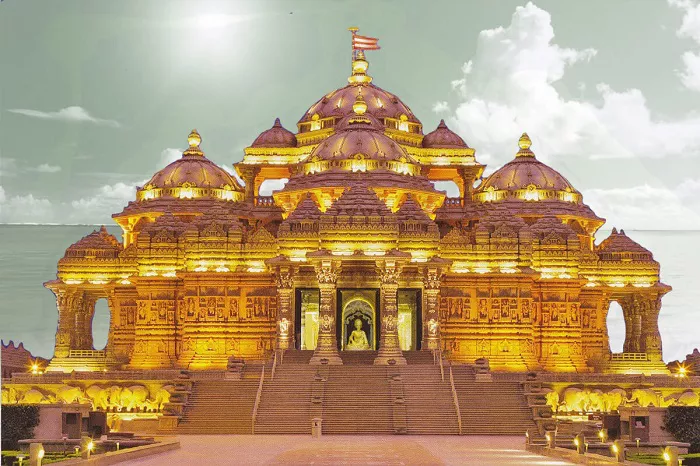India, a land steeped in centuries of history and culture, is home to numerous architectural marvels that continue to captivate travelers from around the world. Among its many historical gems, six stand out for their unique legacy, architectural brilliance, and cultural significance. These sites offer a vivid glimpse into the nation’s diverse past, from the grandeur of empires to spiritual and artistic expressions carved in stone.
1. Taj Mahal – A Monument to Eternal Love (Agra, Uttar Pradesh)
Recognized globally as one of the Seven Wonders of the World, the Taj Mahal in Agra remains India’s most iconic historical landmark. Commissioned in the 17th century by Mughal Emperor Shah Jahan in memory of his wife Mumtaz Mahal, this white marble mausoleum exemplifies enduring love and architectural excellence. Seamlessly blending Persian, Islamic, and Indian styles, the monument is admired for its symmetry, intricate carvings, and the ethereal reflection it casts on the Yamuna River—particularly during sunrise and sunset.
2. Hampi – The Lost Capital of the Vijayanagara Empire (Karnataka)
Once a thriving capital of the Vijayanagara Empire, Hampi is now a UNESCO World Heritage Site that showcases the grandeur of a bygone era. Situated along the Tungabhadra River, the city reached its zenith in the 14th century as one of the world’s wealthiest urban centers. The vast landscape is dotted with over 1,600 well-preserved ruins, including palatial complexes, ancient temples, market avenues, and iconic stone chariots. Noteworthy sites include the Virupaksha Temple, Vittala Temple, and the massive monolithic Nandi.
3. Qutub Minar – A Towering Symbol of Indo-Islamic Architecture (Delhi)
Standing at a height of 73 meters, Qutub Minar is one of Delhi’s most prominent historical structures and a testament to early Indo-Islamic architecture. Construction began in 1193 under Qutb-ud-din Aibak and was completed by his successors. This UNESCO World Heritage Site marks the advent of Muslim rule in India and is embellished with Quranic inscriptions and intricate stone carvings. The surrounding Qutub Complex features several other significant monuments, including the Quwwat-ul-Islam Mosque and the rust-resistant Iron Pillar.
4. Ajanta and Ellora Caves – Masterpieces of Rock-Cut Art (Maharashtra)
The Ajanta and Ellora Caves in Maharashtra are celebrated globally for their extraordinary rock-cut architecture and artistic legacy. The Ajanta Caves, dating back to the 2nd century BCE, are predominantly Buddhist and feature detailed murals and sculptures narrating the life of the Buddha and stories from the Jataka tales. In contrast, the Ellora Caves, carved between the 6th and 10th centuries, reflect a confluence of Buddhist, Hindu, and Jain traditions. The Kailasa Temple, carved from a single rock to resemble Mount Kailash, stands as a highlight of Ellora’s architectural ingenuity.
5. Khajuraho Temples – An Ode to Art, Spirituality, and Sensuality (Madhya Pradesh)
The Khajuraho Group of Monuments, a UNESCO World Heritage Site in Madhya Pradesh, is renowned for its intricately sculpted temples that explore themes of life, spirituality, and human expression. Constructed between 950 and 1050 AD by the Chandela dynasty, these temples are often associated with their erotic carvings—though such depictions constitute only a small fraction of the overall artwork. The majority illustrate everyday life, divine figures, and mythological narratives. The complex is divided into Western, Eastern, and Southern groups, with the Kandariya Mahadeva Temple being the most iconic.
6. Konark Sun Temple – A Celestial Chariot in Stone (Odisha)
Constructed in the 13th century by King Narasimhadeva I of the Eastern Ganga Dynasty, the Konark Sun Temple in Odisha is a monumental representation of Surya, the Sun God. Designed as a colossal stone chariot drawn by seven horses and supported by 24 ornately carved wheels, the structure symbolizes the passage of time and cosmic movement. This UNESCO World Heritage Site is notable not only for its architectural grandeur and astronomical precision but also for its exquisite carvings depicting deities, celestial dancers, musicians, and mythical creatures.
Together, these six sites reflect the rich tapestry of India’s historical, cultural, and artistic achievements. Each destination offers a distinct journey into the country’s vibrant heritage and stands as a testament to the civilizations that shaped the Indian subcontinent.


